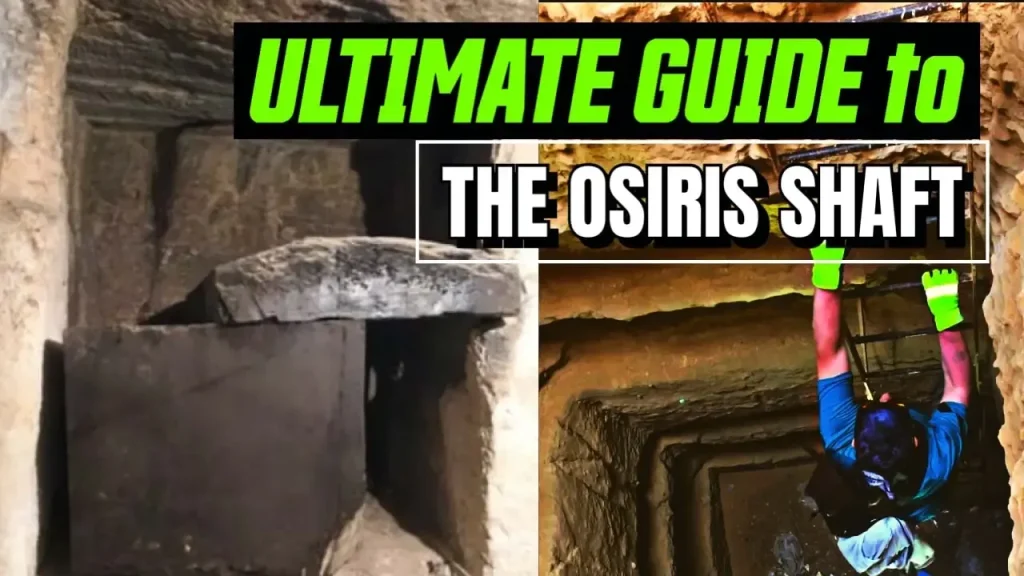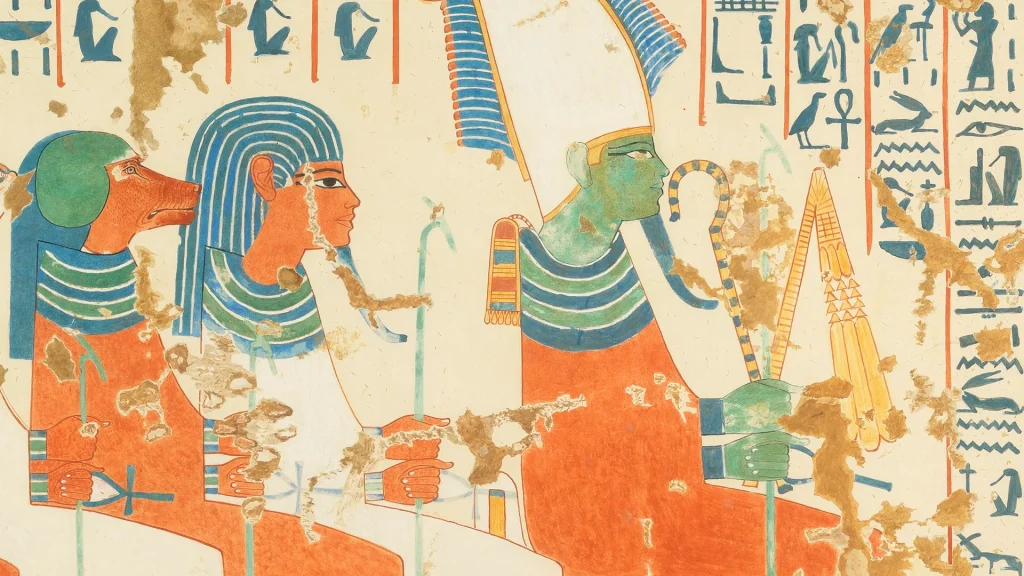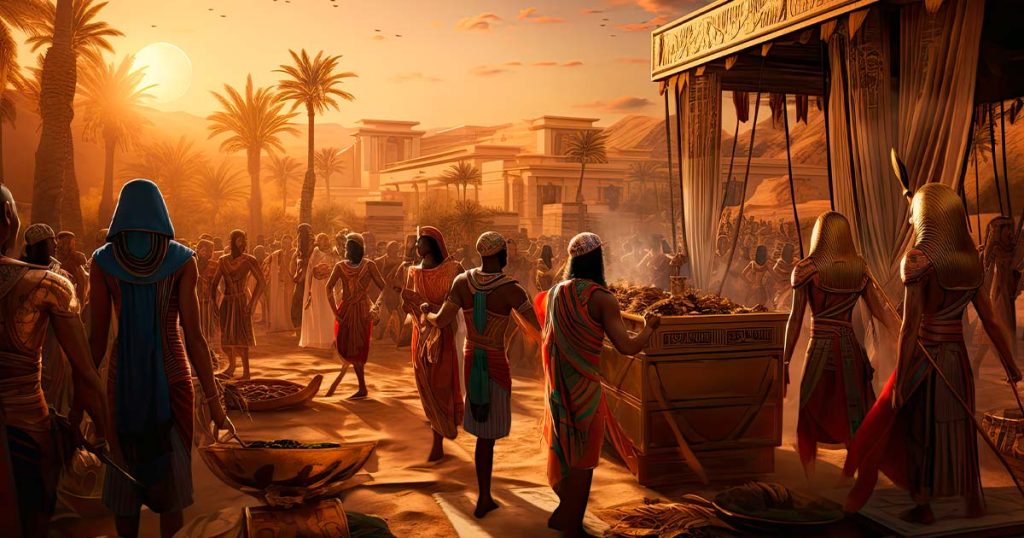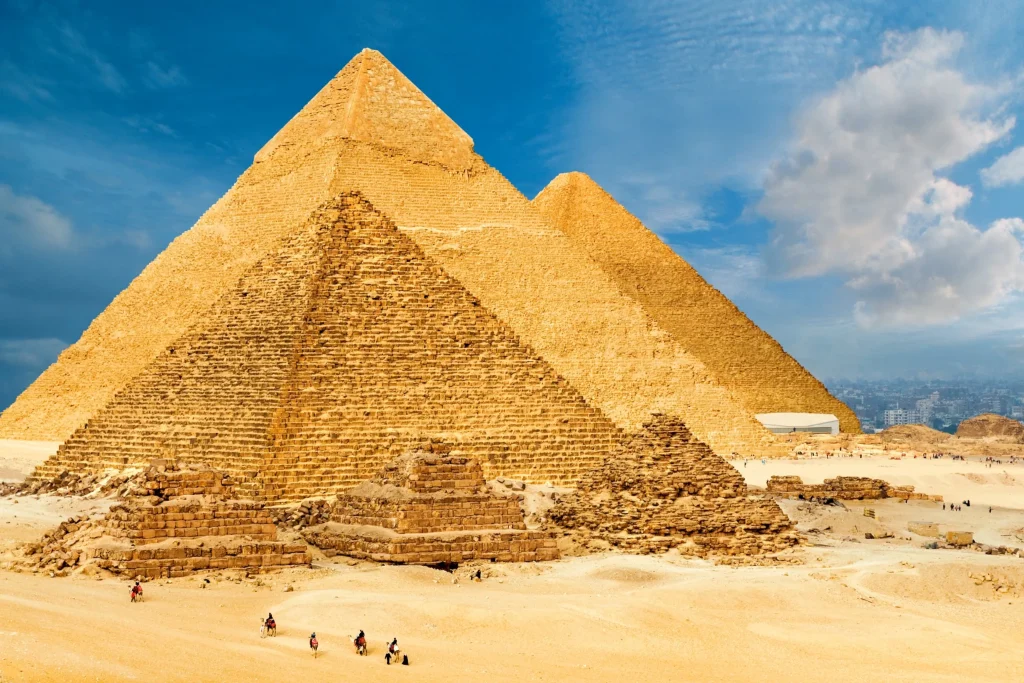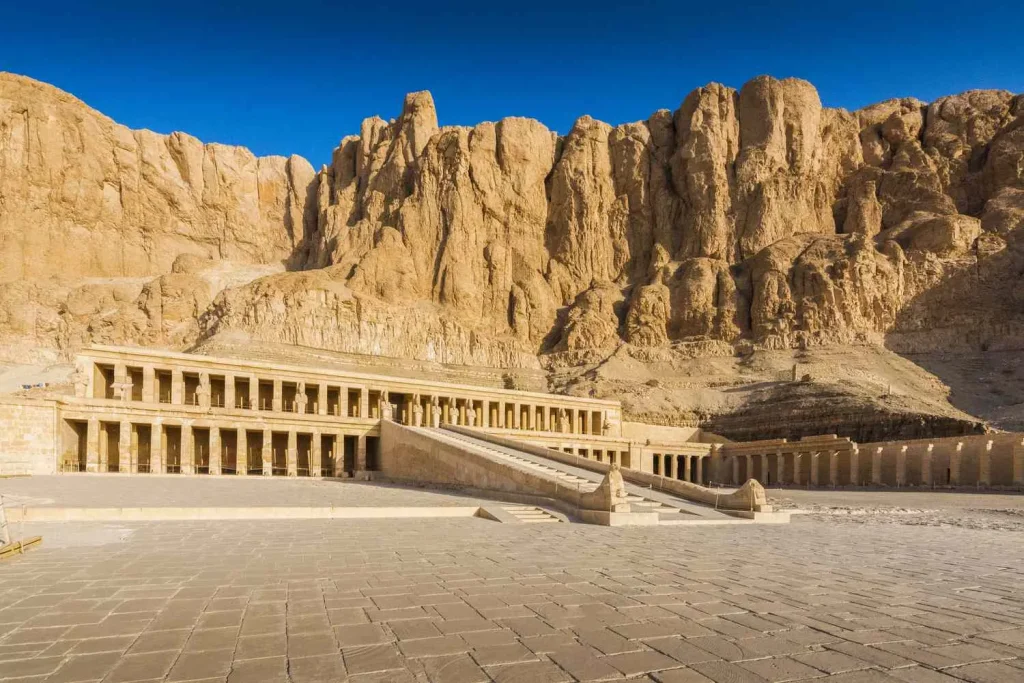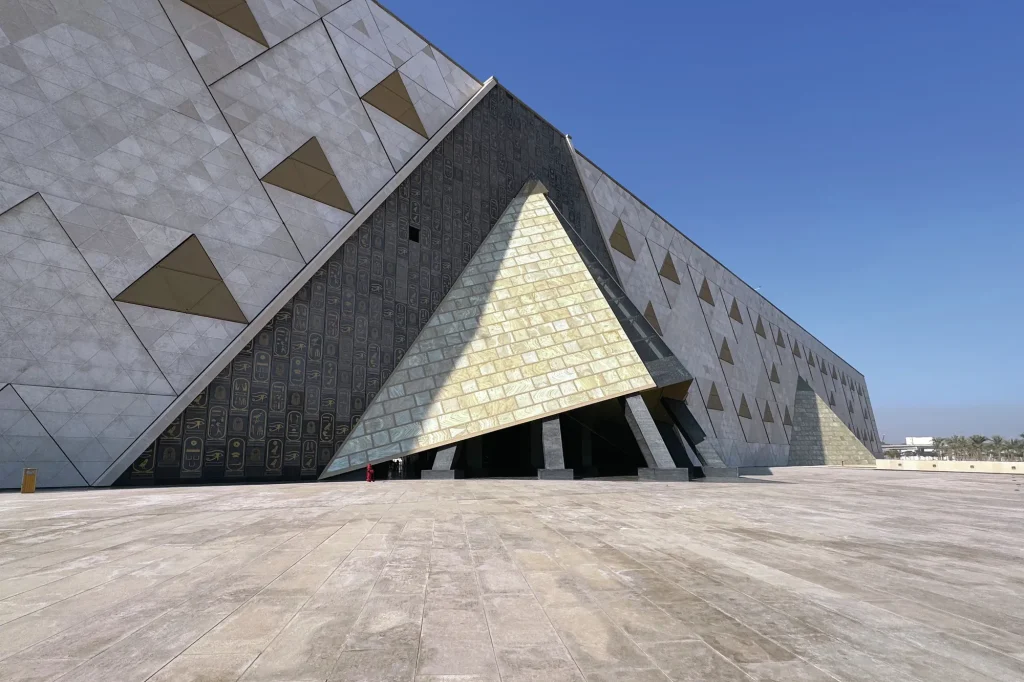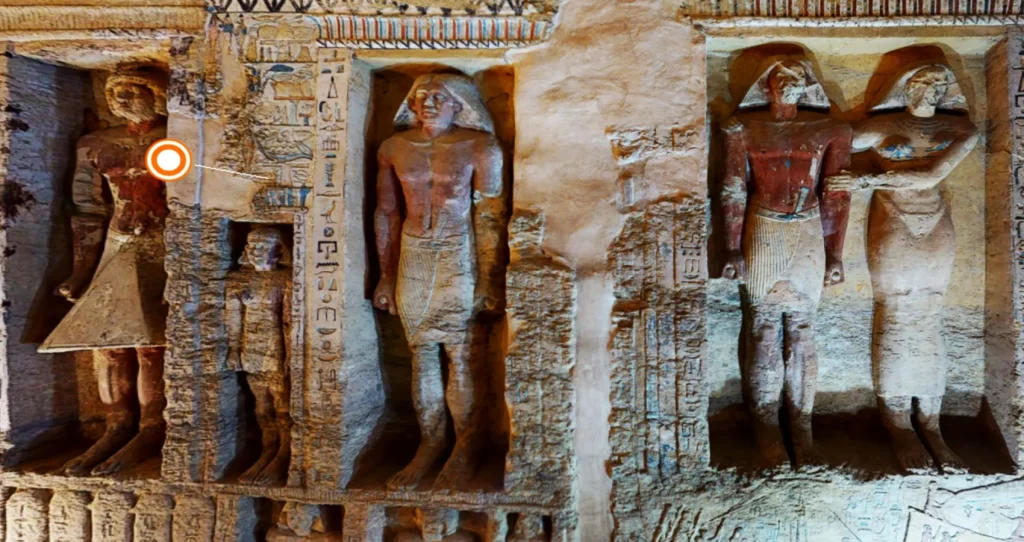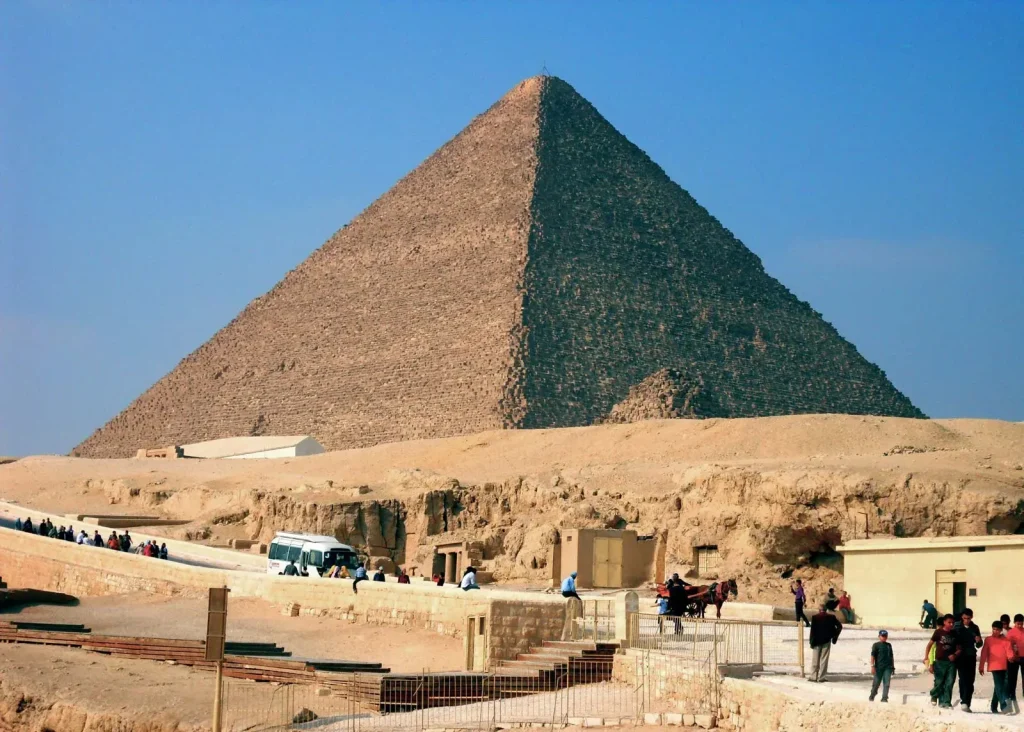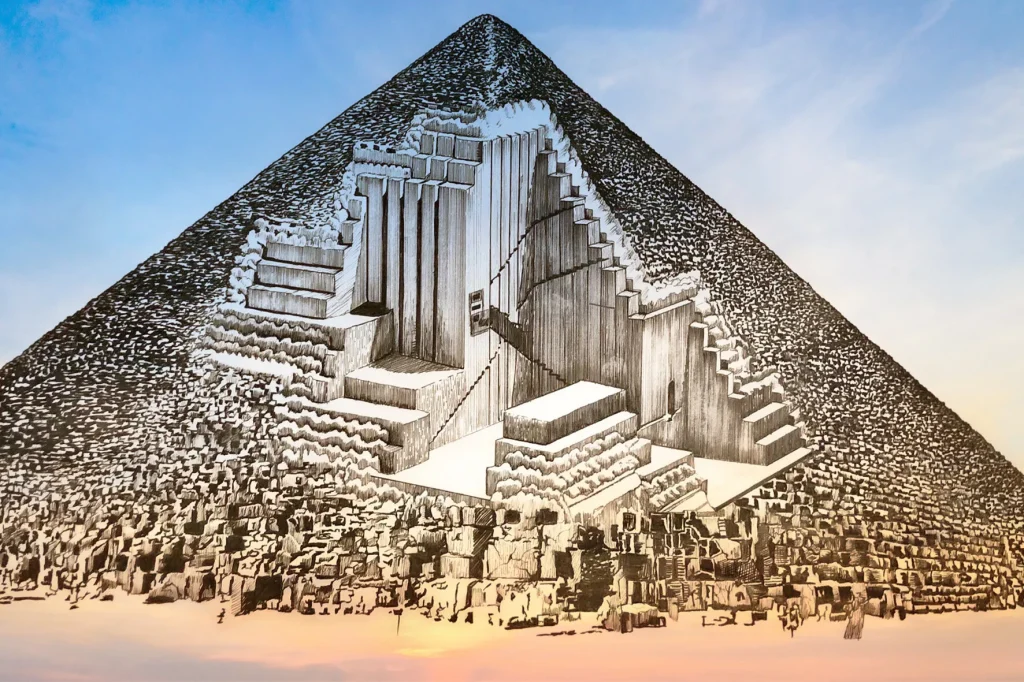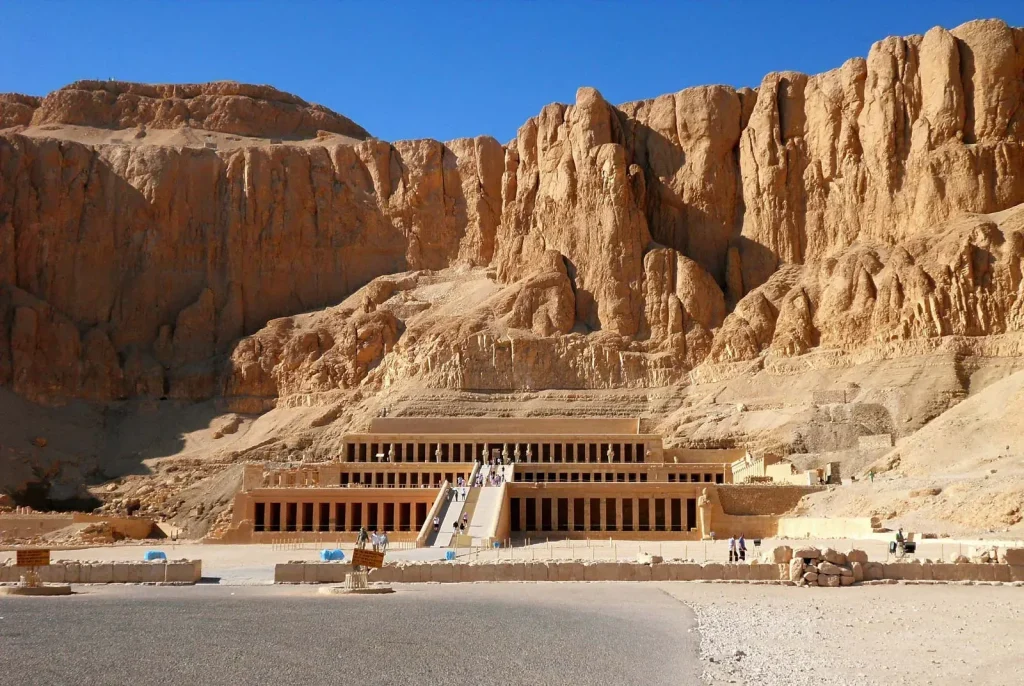Did you know that hidden deep within the Giza plateau lies a remarkable ancient Egyptian tomb known as the Osiris Shaft? This enigmatic tunnel showcases the rich history and archaeological significance of this ancient civilization. Join me on an awe-inspiring exploration of the Osiris Shaft as we uncover its secrets and delve into the mysteries of ancient Egypt.
Key Takeaways:
- Discover the hidden Osiris Shaft buried deep within the Giza plateau.
- Explore the historical context and archaeological significance of this ancient Egyptian tomb.
- Gain insight into the burial practices of pharaohs and the construction of the pyramids.
- Uncover the mysteries and enigma that surround the Osiris Shaft.
- Marvel at ancient Egyptian artifacts and excavations within the Shaft.
The History of the Osiris Shaft
As we amazing into the depths of ancient Egypt’s enigmatic Osiris Shaft, it is essential to understand the rich historical context and its profound connection to the ancient Egyptian civilization. This hidden tunnel, buried within the Giza plateau, unlocks valuable insights into the burial practices of pharaohs and the construction of the pyramids, revealing a tapestry of cultural significance and architectural marvels.
Ancient Egyptian Civilization
The Osiris Shaft stands as a testament to the remarkable achievements of the ancient Egyptian civilization. The civilization, which thrived from the 31st century BCE to the 4th century BCE, is renowned for its sophisticated burial practices and advanced pyramid construction. Through meticulous examination of the Osiris Shaft, historians and archaeologists have pieced together a captivating narrative of this fascinating era.
Burial Practices of Pharaohs
The Osiris Shaft provides invaluable insights into the burial practices of pharaohs, the revered rulers of ancient Egypt. Pharaohs were believed to be divine beings who ascended to the afterlife, and their tombs were constructed to ensure their transition to the realm of the gods. Elaborate rituals, intricate tomb constructions, and carefully preserved burial chambers all played a significant role in guaranteeing the pharaohs’ eternal rest and divine transformation.
The Construction of the Pyramids
The Osiris Shaft’s connection to pyramid construction cannot be overlooked. Pyramids were grand structures built as monumental tombs for pharaohs, serving as a physical representation of their divine status and eternal legacy. The Osiris Shaft offers critical insights into the engineering marvels and construction techniques employed in the creation of these awe-inspiring landmarks.
The Osiris Shaft is a gateway to understanding the ancient Egyptian civilization’s burial practices, the power and significance of pharaohs, and the sheer brilliance of pyramid construction. Join me as we continue our exploration into the mysteries and wonders of the Giza plateau, where ancient history comes alive.
Exploring the Giza Pyramid Complex
Prepare to explore on an extraordinary journey as we delve into the mesmerizing realm of the Giza Pyramid Complex. This magnificent complex, located on the Giza plateau in Egypt, is home to one of the world’s most iconic structures, the Khufu Pyramid, also known as the Great Pyramid of Giza. Tucked within this awe-inspiring complex lies the enigmatic Osiris Shaft, waiting to reveal its secrets.
The Giza Pyramid Complex is a sprawling archaeological site that encompasses not only the Khufu Pyramid but also the Khafre Pyramid and the Menkaure Pyramid. Together, these magnificent structures stand as a testament to the incredible craftsmanship and engineering prowess of the ancient Egyptians.
As you wander through the vast complex, you will be captivated by the stunning architecture and the sheer scale of these ancient wonders. The meticulous planning and precision that went into their construction are evident in every stone and every corridor.
Archaeological Sites within the Complex
While the Khufu Pyramid undoubtedly takes center stage, the Giza Pyramid Complex is also home to several other distinctive archaeological sites. These sites offer invaluable insights into the lives and beliefs of the ancient Egyptians.
- The Sphinx: Majestically guarding the pyramids, the Sphinx is an iconic symbol of ancient Egypt. Its enigmatic expression and grandiose presence have captivated visitors for centuries, making it a must-see attraction within the complex.
- The Valley Temple: Situated next to the Sphinx, the Valley Temple is a remarkable structure that was once used for mortuary rituals and the embalming process. Its well-preserved facade and intricate reliefs offer a glimpse into the rituals and customs of ancient Egyptian burial practices.
- The Solar Barques Museum: Located near the Khufu Pyramid, the Solar Barques Museum houses the remnants of ancient boats that were believed to carry the pharaohs on their celestial journey after death. These exquisitely preserved vessels provide valuable insights into the ceremonial and religious practices of ancient Egypt.
As you explore these archaeological sites, you will be transported back in time, marveling at the ingenuity and symbolism infused within each structure.
Delving into the Mesmerizing Interiors of the Pyramids
One of the most captivating aspects of the Giza Pyramid Complex is the opportunity to explore the intricate interiors of these monumental structures. Step inside the Khufu Pyramid and marvel at its labyrinthine passageways, ascending corridors, and hidden chambers.
Walking through the pyramid’s narrow passages, I couldn’t help but feel a sense of reverence for the ancient pharaohs who once walked these same halls. It’s truly awe-inspiring to imagine the dedication and technical precision required to construct such a monumental masterpiece.
While the interiors of the pyramids may appear austere, they hide a wealth of ancient secrets waiting to be discovered. The hieroglyphic inscriptions, ornate sarcophagi, and intricate burial chambers reflect the deep religious beliefs and complex burial practices of the ancient Egyptian civilization.
| Pyramid | Height (meters) | Construction Time |
|---|---|---|
| Khufu Pyramid | 139 | 20 years |
| Khafre Pyramid | 136 | 25 years |
| Menkaure Pyramid | 65 | 10 years |
The sheer size and complexity of these pyramids are a testament to human ingenuity and stand as a lasting legacy of the pharaohs’ eternal quest for immortality.
Intrigued by the mysteries that lie within the Giza Pyramid Complex? Join me as we continue our exploration into the enigma of the Osiris Shaft, unearthing the secrets of ancient Egypt’s hidden depths.
Ancient Egyptian Tombs
Welcome to the captivating world of ancient Egyptian tombs, where ancient secrets lay hidden beneath the sands. In this section, we will guide you through the renowned Valley of the Kings, home to the sacred burial chambers of pharaohs. Prepare to embark on an extraordinary journey as we explore the mysteries of these ancient resting places and delve into the intricate burial rites of the pharaohs.
Valley of the Kings – Unveiling the Majesty of Ancient Egyptian Tombs
The Valley of the Kings, located on the west bank of the Nile River near Luxor, Egypt, holds a significant place in history. It served as the burial ground for pharaohs and nobles during the New Kingdom period, dating back to the 16th century BC. With its vast collection of royal tombs, this UNESCO World Heritage site continues to astound archaeologists and visitors alike.
| Tomb | Pharaoh | Description |
|---|---|---|
| Tomb of Tutankhamun | Tutankhamun | Discovered by Howard Carter in 1922, this intact tomb revealed exquisite treasures and offered valuable insights into ancient Egyptian burial practices. |
| Tomb of Ramesses IV | Ramesses IV | Known for its beautifully decorated walls and detailed reliefs, this tomb showcases the grandeur and opulence of ancient Egyptian burial chambers. |
| Tomb of Seti I | Seti I | Regarded as one of the most magnificent tombs, it features intricate artwork depicting religious scenes and spells from the Egyptian Book of the Dead. |
As you explore these remarkable tombs, you will witness the intricate carvings, vibrant paintings, and elaborate funerary rituals that were designed to guide the pharaohs into the afterlife. Each tomb tells a unique story, shedding light on the beliefs and customs of ancient Egyptian society.
Burial Chambers: Unearthing Ancient Mysteries
The burial chambers within the ancient Egyptian tombs are awe-inspiring in their grandeur and intricate design. Carved deep into the rocks, these chambers were meant to provide a final resting place fit for a pharaoh.
For the pharaohs, the burial chamber was not only a physical resting place but also a gateway to the afterlife. It was believed that the deceased pharaoh would be reborn in the realm of the gods.
These chambers were adorned with precious jewels, religious symbols, and hieroglyphic inscriptions, all carefully crafted to assist the pharaoh in their spiritual journey. The walls often depicted scenes from ancient Egyptian mythology, ensuring that the pharaoh would have the necessary knowledge and protection in the afterlife.
Pharaoh Burial Rites – A Journey to Immortality
The burial rites of the pharaohs were deeply rooted in ancient Egyptian religious beliefs. These rituals aimed to ensure the pharaoh’s successful transition to the afterlife and their eventual resurrection as an immortal god.
Elaborate ceremonies were conducted by priests and embalmers, involving the mummification of the pharaoh’s body, the entombment of valuable possessions, and the offering of prayers and rituals to appease the gods.
The pharaoh’s body was carefully preserved through the process of mummification, ensuring its longevity in the afterlife. Alongside the pharaoh, a wealth of treasures and symbolic objects were placed in their tombs, including food, furniture, and even servants, to accompany and serve them in the divine realm.
By exploring the ancient Egyptian tombs, we gain a deeper understanding of the rich history and profound beliefs that shaped this remarkable civilization. The Valley of the Kings and its burial chambers continue to fascinate us with their mysteries, offering a glimpse into the eternal fascination with life, death, and the afterlife in ancient Egypt.
The Enigma of the Osiris Shaft
Uncover the enigmatic nature of the Osiris Shaft and its significance within the pyramid complex. This hidden tunnel, located deep within the Giza plateau, holds a wealth of mysteries waiting to be unraveled. Archaeologists and historians have been captivated by this mysterious shaft, leading to intriguing discoveries that shed light on the ancient Egyptian civilization.
The Osiris Shaft, concealed beneath the majestic pyramids, has puzzled experts for centuries. This hidden passage has sparked curiosity and speculation among researchers, who strive to understand its purpose and the secrets it guards. The architectural wonder of the pyramid complex is further enhanced by the presence of this enigmatic shaft, adding a layer of intrigue and mystery to an already awe-inspiring site.
Archaeological excavations within the Osiris Shaft have revealed fascinating discoveries. Explorers have unearthed ancient artifacts and evidence of ritualistic ceremonies, providing valuable insights into the religious practices and beliefs of ancient Egyptians. These findings have allowed historians to piece together the complex tapestry of this magnificent civilization, enhancing our understanding of their customs and traditions.
“The Osiris Shaft is a testament to the ingenuity and sophistication of the ancient Egyptians. Its existence poses intriguing questions about their religious and spiritual practices.” – Dr. Emily Carter, Egyptologist
As researchers delve deeper into the mysteries of the Osiris Shaft, the intrigue continues to grow. The hidden tunnel’s connection to the pyramids and its purpose remain shrouded in ambiguity. Some speculate that it served as a sacred passage for the pharaohs, leading them to the afterlife. Others suggest that it held valuable treasures and offerings for the gods. The truth behind the Osiris Shaft remains an enigma, inviting further exploration and investigation.
The Osiris Shaft stands as a testament to the remarkable achievements of the ancient Egyptians. Its hidden depths reveal a civilization that revered the afterlife and left behind a rich legacy for us to unravel. As we continue to unearth new clues and make archaeological discoveries within this mysterious shaft, we inch closer towards unraveling the secrets of ancient Egypt’s past.
The Secrets of Osiris Shaft Revealed
Journey deep into the heart of the Osiris Shaft as we uncover its long-guarded secrets of ancient Egypt. This mysterious tunnel, intertwined with the enigmatic pyramids, offers a fascinating glimpse into the world of pyramid construction and the wonders of the ancient Egyptian civilization.
As you traverse through the Osiris Shaft, be prepared to marvel at the remarkable ancient Egyptian artifacts that line its walls. Close your eyes and imagine the pharaohs who once commissioned the construction of this monumental structure, their vision and power etched into every stone.
Exploring the different excavation sites within the Shaft is like unraveling a tapestry of ancient history. Each site holds clues and remnants of a bygone era, shedding light on the ingenuity and craftsmanship of the ancient Egyptians. From the tools and techniques used in pyramid construction to the religious significance attributed to these grand structures, every corner of the Osiris Shaft tells a captivating story.
The Pharaohs: Architects of the Ancient World
“The pharaohs were not just rulers but also visionary architects who shaped the landscape of ancient Egypt. Through the construction of pyramids, they sought eternal glory and a divine connection with the gods.”
Step into their world as you explore the excavation sites and marvel at the intricate design and engineering behind these ancient marvels. The Osiris Shaft reveals the ingenuity of pyramid construction, showcasing the precision and planning required to create these awe-inspiring structures that have stood the test of time.
Excavation sites within the Osiris Shaft provide researchers and archaeologists with a wealth of knowledge about ancient Egyptian civilization. Uncovering artifacts and deciphering their significance offers valuable insights into the rituals, beliefs, and daily life of the people who lived during this extraordinary period in history.
The Osiris Shaft Excavation Sites: A Glimpse of Ancient Egypt
| Excavation Site | Description |
|---|---|
| The Great Pyramid | Explore the inner chambers of the largest pyramid in Giza, marveling at the intricate passages and burial chambers. |
| The Sphinx | Gaze upon the majestic Sphinx, an iconic monument that guards the entrance of the Osiris Shaft and holds countless mysteries. |
| The Valley of the Kings | Uncover the hidden tombs of pharaohs in the Valley of the Kings, revealing the opulence and grandeur of their final resting places. |
| The Mortuary Temple of Hatshepsut | Step back in time as you explore the magnificent mortuary temple dedicated to the female pharaoh Hatshepsut, a testament to her reign and legacy. |
With each excavation site offering a unique perspective on ancient Egypt, the Osiris Shaft opens a gateway to uncovering the secrets of this remarkable civilization. Prepare to be captivated as you journey through time and immerse yourself in the wonders of the Osiris Shaft.
Exploring Osiris Shaft Tunnels
Venture further into the Osiris Shaft as we explore the intricate network of tunnels. These tunnels not only showcase the architectural brilliance of ancient Egypt but also provide a glimpse into the burial practices and religious beliefs of the time.
Ancient Burial Chambers
As you navigate the Osiris Shaft tunnels, you’ll encounter ancient burial chambers that have remained untouched for centuries. These chambers serve as a haunting reminder of the mysteries surrounding the afterlife and the rituals associated with it.
Inside these chambers, you may come across a plethora of historical artifacts. From intricately carved sarcophagi to elaborate funerary offerings, each artifact tells a unique story about the individual who was laid to rest within the chamber.
Historical Artifacts
The Osiris Shaft tunnels are rich in historical artifacts, providing invaluable insights into the ancient Egyptian civilization. These artifacts include statues, intricate amulets, and priceless jewelry, all of which offer a glimpse into the artistic achievements and craftsmanship of the time.
These artifacts not only showcase the wealth and power of the pharaohs, but also shed light on the daily lives and beliefs of the ancient Egyptians. They provide a tangible connection to a civilization that existed thousands of years ago.
Archaeological Discovery
Exploring the Osiris Shaft tunnels is not only an opportunity to observe historical artifacts but also to participate in the ongoing archaeological discovery. Archaeologists continue to uncover new treasures and unravel the mysteries hidden within these tunnels, adding to our understanding of ancient Egyptian culture and burial practices.
By exploring the Osiris Shaft tunnels, we contribute to the preservation and research of these fascinating archaeological sites. Each visit brings us closer to unraveling the secrets of ancient Egypt and understanding the significance of the Osiris Shaft within this remarkable civilization.
The Sealed Off Side Tunnel of Osiris Shaft
As we unravel the mysteries of the Osiris Shaft, we come across a fascinating discovery—the sealed off side tunnel. Located deep within the shaft, this hidden passage holds secrets waiting to be uncovered.
The decision to close off the side tunnel was not taken lightly. Archaeologists and experts carefully evaluated the risks and benefits before sealing it. The reasons behind its closure are multifaceted, involving both preservation concerns and the need for further exploration.
Preservation of the Osiris Shaft is of paramount importance. With its historical and archaeological significance, it’s crucial to safeguard the shaft and its treasures. By sealing off the side tunnel, researchers aim to protect the delicate balance within the shaft, preventing any potential damage or degradation.
However, the closure of the side tunnel does not mark the end of its story. On the contrary, it ignites curiosity and creates anticipation for future exploration. What mysteries lie within the sealed tunnel? What ancient secrets are yet to be discovered? These questions fuel the desire to continue investigating the Osiris Shaft and its hidden chambers.
The Osiris Shaft, with its sealed off side tunnel, serves as a reminder that ancient Egypt still holds many secrets waiting to be uncovered. It speaks to the enduring allure of this civilization and the ongoing pursuit of knowledge in archaeology and Egyptology.
Famous Encounters – Joe Rogan’s Osiris Shaft Episode
One of the most notable encounters with the Osiris Shaft came from none other than Joe Rogan himself. In a captivating episode of his podcast, Joe Rogan discussed his experience exploring the depths of this incredible archaeological site.
During the episode, Joe Rogan delved into the rich history and significance of the Osiris Shaft. He shared his awe-inspiring encounter with the hidden tunnel, shedding light on the mysteries that lie within. His firsthand account provided a unique perspective on this ancient marvel and its importance to our understanding of ancient Egypt.
If you’re eager to listen to Joe Rogan’s discussion about the Osiris Shaft, check out episode [INSERT EPISODE NUMBER]. This enlightening conversation offers a fascinating glimpse into the wonders of ancient Egypt and the allure of the Osiris Shaft.
Osiris Shaft – Insights from Egyptology Research
As we delve into the captivating wonders of the Osiris Shaft, it is essential to explore the extensive research and wealth of knowledge provided by egyptology experts. To gain a deeper understanding of this ancient marvel, one valuable resource to consult is the Osiris Shaft Wikipedia page.
Wikipedia, an open-source platform, offers a comprehensive overview of the Osiris Shaft, providing historical context, archaeological findings, and scholarly interpretations. The page covers key aspects such as the construction, purpose, and exploration of this enigmatic tunnel. Through this collaborative effort, egyptology enthusiasts and researchers have contributed their expertise to create a reliable source of information.
However, it is important to supplement our knowledge with other reputable sources and scholarly articles beyond Wikipedia. Delving into egyptology research allows us to unveil a comprehensive understanding of the Osiris Shaft, uncovering interpretations, theories, and insights from esteemed Egyptologists.
Notable Egyptology Researchers and Their Contributions
To gain a deeper insight into the Osiris Shaft, here are a few renowned egyptology researchers and their notable contributions:
- Dr. Zahi Hawass: Renowned Egyptologist known for his extensive work in Egyptology research, Dr. Hawass has made significant contributions to our understanding of ancient Egypt. His studies on the pyramids, including the Osiris Shaft, offer valuable insights into their construction and purpose.
- Dr. Mark Lehner: A leading expert in ancient Egyptian archaeology, Dr. Lehner has conducted extensive excavations and research in the Giza plateau. His studies on the Giza pyramid complex provide valuable context for exploring the Osiris Shaft.
- Dr. Kara Cooney: An Egyptologist and professor, Dr. Cooney has focused her research on ancient Egyptian culture and society. Her expertise sheds light on the religious and social significance of ancient Egyptian tombs and burial practices, including those related to the Osiris Shaft.
By exploring the works of these distinguished researchers and others, we can deepen our understanding of the Osiris Shaft, its historical context, and its place within the ancient Egyptian civilization. Studying egyptology research not only broadens our knowledge but also allows us to appreciate the immense efforts undertaken to unravel the mysteries of this ancient wonder.
Captivating Photographs of Osiris Shaft
Immerse yourself in the captivating visuals of the Osiris Shaft. Witness the awe-inspiring beauty of this ancient monument through stunning photographs that capture its grandeur and mystique. From the intricate architectural details to the sheer magnitude of the structure, these images vividly depict the rich history and cultural significance of the Osiris Shaft.
As you explore the photographs, your eyes will be drawn to the iconic Sphinx, a prominent feature near the site. The Sphinx, with its enigmatic smile and majestic presence, adds an air of mystery and intrigue to the surrounding landscape. Its imposing stature and timeless charm make it a captivating subject in countless Osiris Shaft photos.
With each picture, you’ll find yourself transported to a bygone era, where ancient civilizations thrived and legends were born. The Osiris Shaft pictures provide a glimpse into the past, allowing you to visualize the monumental efforts undertaken by the ancient Egyptians to construct such remarkable structures.
From different angles and perspectives, these photos reveal the Osiris Shaft’s unique architectural elements and highlight the intricate craftsmanship that went into its creation. Whether it’s the detailed carvings on the walls or the elaborate hieroglyphics that adorn the corridors, each image paints a vivid picture of the ancient world.
As you browse through the Osiris Shaft photos, take a moment to imagine yourself standing in the midst of this historical marvel. Let the images transport you to a time long gone, where pharaohs walked the earth and the pyramids stood tall against the horizon. It’s a visual journey that is sure to leave a lasting impression.
Conclusion
I hope you have enjoyed this remarkable journey into the depths of ancient Egypt’s Osiris Shaft. Throughout our exploration, we have uncovered the historical significance, archaeological discoveries, and enduring mysteries that make this site an awe-inspiring testament to a fascinating civilization.
The Osiris Shaft not only provides insight into ancient Egyptian burial practices and pyramid construction but also begs questions about the purpose of its hidden tunnels and sealed off side tunnel. It continues to captivate the imaginations of researchers and visitors alike, leaving us with a sense of wonder and curiosity.
As we reflect on the ancient wonders of the Osiris Shaft, let us appreciate the efforts of Egyptologists and archaeologists who tirelessly work to unravel its secrets. With ongoing research and exploration, who knows what new revelations await us in the years to come.
FAQ
What is the Osiris Shaft?
The Osiris Shaft is a hidden tunnel located within the Giza plateau in Egypt. It is a remarkable archaeological discovery that offers fascinating insights into ancient Egyptian history and civilization.
Where is the Osiris Shaft located?
The Osiris Shaft is situated within the Giza pyramid complex in Egypt. Specifically, it can be found near the Khufu pyramid, one of the most iconic pyramids in Egypt.
What is the historical significance of the Osiris Shaft?
The Osiris Shaft is historically significant as it provides valuable information about ancient Egyptian burial practices, pyramid construction, and the role of pharaohs in ancient Egypt. It sheds light on the rich cultural and architectural heritage of the ancient civilization.
Can visitors explore the Osiris Shaft?
Currently, the Osiris Shaft is sealed off and not open for public exploration. However, there may be opportunities in the future to visit the site under the guidance of professional archaeologists and researchers.
What can be found inside the Osiris Shaft?
The exact contents of the Osiris Shaft remain a mystery. However, it is speculated that it may contain ancient artifacts, inscriptions, and possibly even the remains of prominent historical figures from ancient Egypt.
Are there other tunnels within the Osiris Shaft?
Yes, there is an intricate network of tunnels within the Osiris Shaft. These tunnels, although unexplored, may hold additional archaeological wonders and provide further insights into ancient Egyptian civilization.
What is the significance of the sealed off side tunnel within the Osiris Shaft?
The sealed off side tunnel within the Osiris Shaft is of great interest to archaeologists and researchers. While its current closure prevents exploration, it is believed to hold important clues and valuable artifacts that could enhance our understanding of ancient Egypt.
Has the Osiris Shaft been featured in any media?
Yes, the Osiris Shaft was discussed in an episode of the popular podcast “The Joe Rogan Experience.
Where can I find more information about the Osiris Shaft?
You can find more information about the Osiris Shaft on its Wikipedia page and through various resources on egyptology research. These sources provide detailed insights into the history, significance, and mysteries surrounding this fascinating site.
Are there any photographs available of the Osiris Shaft?
Yes, there are stunning photographs capturing the beauty and intrigue of the Osiris Shaft. These images showcase the remarkable architecture and ancient artifacts within the site. Additionally, some photographs feature the iconic Sphinx, a neighboring landmark to the Osiris Shaft.

